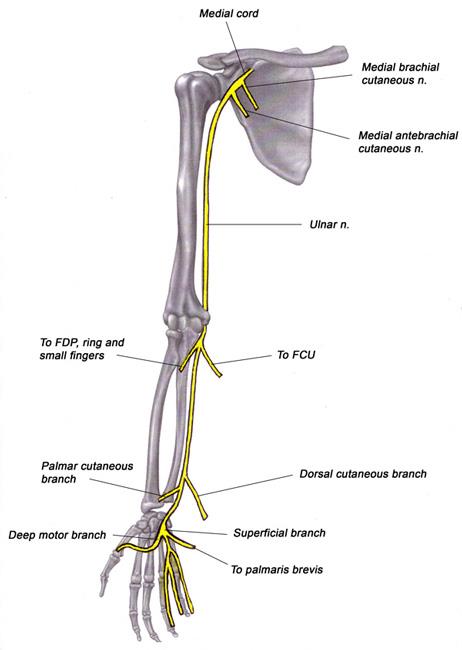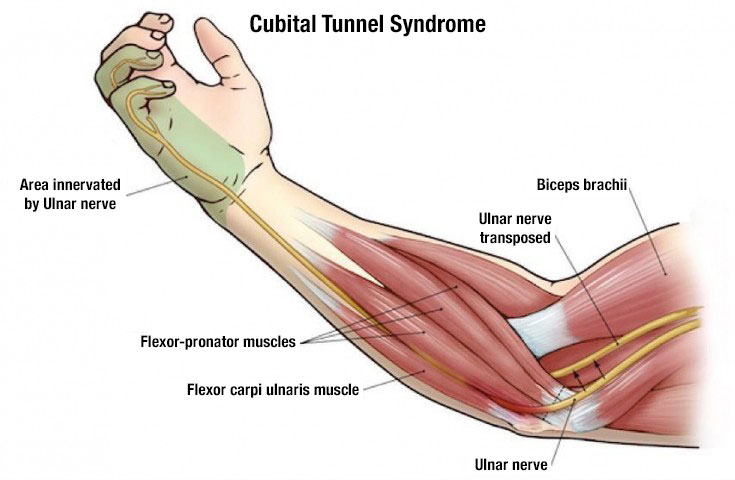
Ulnar Nerve Compression, also known as ulnar neuropathy or cubital tunnel syndrome, occurs when the ulnar nerve, which runs from the neck to the hand, becomes compressed or irritated. This nerve is responsible for controlling the movement and sensation in the ring and little fingers, as well as part of the forearm. When compression occurs, it can lead to various symptoms and functional impairments.
Ulnar nerve compression, frequently referred to as ulnar neuropathy or cubital tunnel syndrome, is a condition characterized by the compression or irritation of the ulnar nerve. This nerve, one of the major nerves in the arm, extends from the cervical spine (neck) down to the hand and is crucial for controlling movement and sensation in the ring and little fingers, as well as part of the forearm. The ulnar nerve plays a vital role in hand and finger function, and when it is compressed, it can lead to a range of symptoms and functional impairments.
The ulnar nerve travels from the brachial plexus, a network of nerves near the cervical spine, through the arm and forearm, eventually reaching the hand. It passes through the cubital tunnel at the elbow, a narrow passageway formed by bone and soft tissue. The ulnar nerve is responsible for the movement and sensation in the fourth and fifth fingers (ring and little fingers) and controls several muscles in the forearm and hand, including those responsible for fine motor skills.

Ulnar Nerve Compression, often referred to as ulnar neuropathy or cubital tunnel syndrome, is a condition where the ulnar nerve becomes compressed or irritated along its pathway. The ulnar nerve is one of the major nerves in the arm and travels from the cervical spine (neck) down to the hand, providing sensation to the ring and little fingers and controlling muscles in the forearm and hand.
The ulnar nerve runs through several anatomical structures in the arm, including the cubital tunnel at the elbow. The cubital tunnel is a narrow passageway formed by bone and soft tissue on the inner side of the elbow. Compression of the ulnar nerve in this area is commonly known as cubital tunnel syndrome.
Ulnar nerve compression, also known as ulnar neuropathy, can occur at various points along the ulnar nerve’s pathway. Each type of ulnar nerve compression is associated with specific anatomical locations and underlying causes. Understanding these types can help in diagnosing and selecting appropriate treatment options.
Cubital tunnel syndrome is the most common form of ulnar nerve compression. It occurs when the ulnar nerve becomes compressed or irritated at the cubital tunnel, which is located at the inner side of the elbow. The cubital tunnel is a space formed by bone and soft tissue through which the ulnar nerve passes. This condition is often caused by:
Symptoms typically include tingling, numbness, and weakness in the ring and little fingers, as well as pain along the inner elbow.
Guyon’s canal syndrome, also known as ulnar tunnel syndrome, occurs when the ulnar nerve is compressed at Guyon’s canal, located at the wrist. This canal is a narrow passageway in the wrist through which the ulnar nerve and artery pass. Compression in this area can be caused by:
Symptoms of Guyon’s canal syndrome may include numbness and tingling in the ring and little fingers, as well as weakness in hand movements.
This type of compression occurs when the ulnar nerve is compressed behind the medial epicondyle of the humerus (a bony prominence on the inner elbow). Retrocondylar compression can be caused by:
Symptoms are similar to those of cubital tunnel syndrome and may include tingling, numbness, and pain in the inner elbow and fingers.
Intraneural compression involves direct compression of the ulnar nerve within its own sheath. This can occur due to:
Symptoms of intraneural compression vary based on the location and severity of the compression but often include persistent pain, weakness, and sensory changes.
Post-traumatic ulnar nerve compression occurs as a result of an injury or surgery that affects the ulnar nerve. Causes include:
Symptoms depend on the extent of the trauma but often involve pain, numbness, and weakness in the hand and fingers.
Ulnar nerve compression, also known as ulnar neuropathy or cubital tunnel syndrome, can present with a range of symptoms that vary depending on the severity and location of the nerve compression. The symptoms generally affect the hand, forearm, and elbow, and can impact daily activities and quality of life. Here is a detailed exploration of the symptoms associated with ulnar nerve compression:
1. Tingling and Numbness:
2. Decreased Sensation:
1. Weakness in the Hand:
2. Atrophy of Hand Muscles:
1. Clumsiness:
2. Difficulty with Fine Motor Skills:
1. Elbow Pain:
2. Radiating Pain:
1. Decreased Grip Strength:
2. Hand Fatigue:
Ulnar nerve compression can profoundly affect daily activities and overall quality of life, manifesting in various sensory, motor, and functional symptoms. From tingling and numbness in the fingers to weakness and clumsiness in hand movements, addressing these symptoms promptly is crucial for effective management and recovery. If you are experiencing any signs of ulnar nerve compression, consulting a specialist is essential for a thorough evaluation and tailored treatment plan. Dr. Amit Deora, a renowned neurosurgeon in Indore, offers expertise in diagnosing and treating complex nerve conditions, including ulnar nerve compression. Additionally, seeking advice from a neurologist in Indore can provide a comprehensive approach to managing your symptoms and improving your overall well-being.